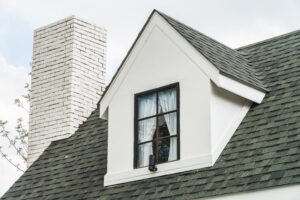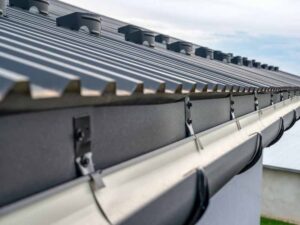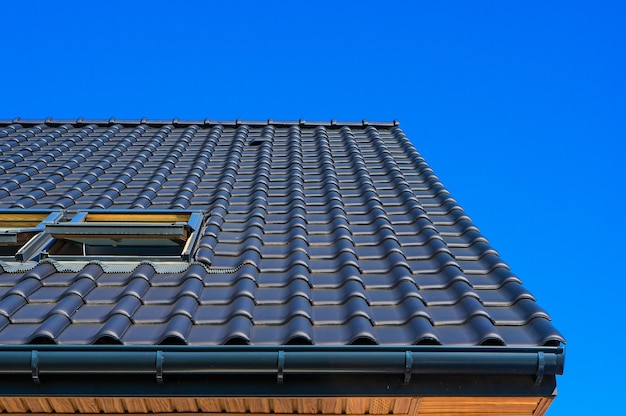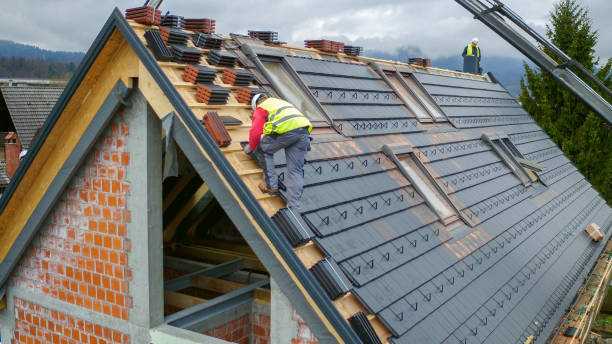Choosing the right roofing material is crucial for the longevity and safety of your home. Roofing and other materials protect your home from weather, enhance its appearance, and contribute to energy-efficient roofing. This article answers the question, “What are the top 5 roofing materials??” by discussing the advantages, disadvantages, and suitability of asphalt shingles, metal roofing, wood shingles, clay and concrete tiles, and slate roofing. These common roofing materials are popular for residential roofing due to their durability, cost-effectiveness, and aesthetic appeal.
1. Asphalt Shingles: Affordable and Versatile

Asphalt shingles are the most common roofing material in North America. This type of roofing includes 3-tab shingles, dimensional shingles, and luxury shingles. Asphalt shingle roofs are known for their versatility and ease of installation. They offer a range of styles and colors, making them a popular choice green roof top for homeowners looking to enhance their home’s curb appeal.
Advantages
Asphalt shingles are a low-cost roofing material, making them accessible for many homeowners. They are easy to install, which helps reduce labor costs and the overall expense of the roofing project. The wide variety of colors and styles available allows homeowners to customize their roofs to match their home’s exterior. Asphalt shingles also offer good performance in terms of waterproofing and weather resistance. They can effectively protect homes from rain, wind, and other elements. Additionally, many asphalt shingles come with warranties, providing peace of mind to homeowners.
Disadvantages
The lifespan of asphalt shingle roofs is shorter compared to other roofing materials, typically lasting between 20 to 30 years. This shorter lifespan means that homeowners may need to replace their roofs more frequently, leading to higher long-term costs. Asphalt shingles also have a higher carbon footprint because they are petroleum-based. The production process and disposal of these shingles can contribute to environmental concerns. In extreme weather conditions, such as heavy storms or high winds, asphalt shingles may be more prone to damage, including cracking, curling, or being blown off. They also have less insulation compared to some other roofing materials, which can affect energy efficiency.
Suitability
Asphalt shingles are suitable for various climates and architectural styles. They are particularly ideal for moderate climates where the weather is not too harsh. However, they may not be the best option for areas with extreme weather conditions, such as high winds, heavy snowfall, or intense heat. Asphalt shingles are a good choice for residential roofing due to their cost-effectiveness and decent life expectancy. They work well for traditional and contemporary homes alike, making them a versatile option for many. Homeowners who prioritize budget and aesthetic options may find asphalt shingles an appealing choice.
2. Metal Roofing: Durable and Energy-Efficient

Metal roofing includes materials such as steel, aluminum, copper, and zinc, and is known for its reflective roofing properties. Manufacturers can form metal roofs into panels, shingles, or tiles. Standing seam metal roofing is a popular type of metal roof known for its durability and sleek appearance. Metal roofing offers both functional and aesthetic benefits, making it a versatile choice of residential roofing materials for many building types.
Advantages
Metal roofing is an extremely durable roofing material, with a lifespan of 40 to 70 years. Metal roofs are fire-resistant, providing added safety to homes and buildings. They are energy-efficient, reflecting UV rays and reducing energy costs. Metal roofs are virtually maintenance-free, requiring minimal upkeep compared to other roofing materials. Their ability to withstand extreme weather conditions, such as heavy snow, strong winds, and hail, makes them a reliable option. Moreover, metal roofs are often made from recycled materials and can be recycled again at the end of their lifespan, contributing to environmental sustainability.
Disadvantages
The initial cost of a metal roof is higher than that of asphalt shingles. Homeowners need to consider this upfront investment. Metal roofs can be noisy during heavy rain or hail, but proper insulation can mitigate this issue. Some people might find the noise a disadvantage, while others may not mind it. Additionally, the installation process requires specialized skills and tools, which can increase labor costs. In areas with high humidity, metal roofs may be prone to rust if not properly treated or coated, although many modern metal roofs come with rust-resistant finishes.
Suitability
Metal roofing is ideal for areas with severe weather, such as heavy rain, snow, or high temperatures. It performs well in regions prone to wildfires due to its fire-resistant properties. Standing seam metal roofing is suitable for both residential and commercial buildings. The longevity and low maintenance of standing seam metal roofing make it a great investment for long-term homeowners. Metal roofs are also well-suited for homes with solar panels, as the panels can be easily installed on the standing seam metal roof, without compromising its integrity. Their aesthetic versatility allows them to complement a variety of architectural styles, from modern to traditional.
3. Wood Shingles and Shakes: Natural and Rustic

Wood shingles and wood shakes, including cedar shingles, come from natural wood, such as cedar and redwood. Wood shingles are machine-cut, offering a smooth and uniform look. Wood shakes are hand-split, providing a rustic appearance. Many homeowners choose wood roofing for its natural aesthetic.
Advantages
Wood shingles and shakes offer a beautiful, natural look. They provide good insulation properties, helping to reduce energy costs. Natural wood enhances the overall appearance of the solar roof and shingles on a home, making it a popular roofing material for certain architectural styles. Additionally, wood roofing materials can blend well with the environment, giving homes a unique charm.
Disadvantages
Wood roofing requires regular maintenance to prevent issues like mold, rot, and insect damage. Homeowners need to inspect and treat composite shingles on the roof frequently to keep it in good condition. Wood shingles and shakes are also more susceptible to fire. However, treated wood products can reduce this risk. The cost of green roof for maintenance and treatment can be higher compared to other roofing materials.
Suitability
Wood roofing is suitable for homes in dry climates where there is less risk of moisture-related problems. They are ideal for homeowners seeking a natural, rustic look and willing to invest in regular maintenance. This type of roofing works well in areas with low humidity and minimal rainfall. It is also a good choice for houses with a traditional or historical design. The combination of natural beauty and insulation benefits makes wood shingles and shakes an attractive option for many.
4. Clay and Concrete Tiles: Stylish and Long-Lasting

Clay tiles and concrete tiles, including Spanish tile, are popular choices for roofing in Mediterranean, Spanish, and Southwestern-style homes. Manufacturers make terra cotta clay tile or tiles from natural clay, which they fire in kilns. In contrast, they make concrete tiles from a mixture of sand, cement, and water. Terra and terra cotta clay tile or tiles are particularly popular for their classic appearance.
Advantages
Clay and concrete tiles offer several benefits. These tiles are extremely durable, often lasting over 50 years. They are fire-resistant, providing an extra layer of safety for homes. Maintenance needs for these tiles are minimal. Furthermore, these tiles can withstand high temperatures and other severe weather conditions, making them a reliable choice for many homeowners.
Disadvantages
Clay and concrete tiles have some drawbacks. Their weight is significant, with concrete tile requiring strong roof reinforcement to support them. These tiles are also more expensive than other roofing options. The complexity of installing clay and concrete tiles increases the overall cost per square on of a new roof, making them a pricier option.
Suitability
Clay and concrete tiles are ideal for hot climates. These tiles reflect sunlight, helping to keep homes cool. They are suitable for flat roofs and for homes with strong structural support due to their weight. Homeowners looking for a long-term roofing solution will find clay tile and concrete tiles a worthwhile investment.
5. Slate Roofing: Timeless and Elegant

Slate roofing, made from natural slate tiles, offers a unique and elegant appearance. This type of roofing includes many roofs covered with both natural slate tiles and synthetic slate options. Homeowners appreciate slate roofs for their longevity and aesthetic appeal.
Advantages of Slate Roofing
Slate roofs are highly durable and have a lifespan of over 100 years. Slate is durable roofing material that is fire-resistant, which provides added safety. These roofs can withstand extreme weather, making them reliable in various climates. Slate roofs add a touch of elegance to any building and increase the overall value of a home.
Disadvantages of Slate Roofing
The main disadvantage of slate roofing is its high cost. Slate is one of the most expensive roofing materials available. Slate roofs are also heavy, requiring a strong roof decking and reinforcement. Installation and repair of slate roofs require specialized skills, which increases a professional roofing contractor and material overall cost.
Suitability of Slate Roofing
Slate roofing is suitable for high-end homes and buildings where aesthetics and longevity are priorities. Slate tile roofs are ideal for areas with severe weather due to their durability. Homeowners must ensure their roof structure can support the weight of slate roof tiles before choosing this option.
General Guide on How to Take Care of the Top 5 Roofing Materials
Proper maintenance of roof materials is essential for extending the lifespan of your roof and ensuring its functionality. Regular care of roof materials can prevent costly repairs and roof replacement. This guide will provide detailed maintenance tips for asphalt shingles, metal roofing, wood shingles and shakes, clay and concrete tiles, and slate roofing.
Asphalt Shingle Roof
Regular Inspections: Regular inspections are crucial for maintaining an asphalt shingle roof. You should check for damaged, loose, or missing shingles at least twice a year, preferably in spring and fall. Inspect the roof after severe weather events to ensure shingles are intact and the roof deck is not exposed. Look for signs of wear such as curling, buckling, or blistering shingles.
Cleaning and Debris Removal: Keep the asphalt shingle roof clean by removing leaves, branches, and other debris. This prevents moisture buildup, which can lead to mold and mildew. Use a soft brush or leaf blower to avoid damaging the shingles. Cleaning the roof helps prevent the growth of algae, which can discolor the shingles and shorten their lifespan, even if you have algae-resistant shingles.
Repairing and Replacing Shingles: Promptly repair or replace damaged shingles to prevent leaks and further damage to the roof deck. Use roofing cement to secure loose shingles and patch minor cracks. For more extensive damage, hiring a professional roofer ensures repairs are done correctly. Regular maintenance helps maintain the weather resistance of the roof.
Metal Roofing
Inspections and Cleaning: Inspect metal roofs, especially standing seam metal roofs, at least twice a year. Look for signs of rust, loose fasteners, and sealant issues. Clean the roof with water and mild detergent to remove dirt and debris, maintaining the cool roofing properties of metal roofs. Avoid using abrasive cleaners or tools that can scratch the metal.
Rust Prevention and Repair: Treat any rust spots promptly to prevent them from spreading. Use a metal roof coating or rust inhibitor to protect the surface. For significant rust damage, consult a professional roofer for repairs. Regularly applying a protective coating can help maintain the roof’s appearance and durability.
Checking Fasteners and Seams: Ensure all fasteners and seams on metal panels are secure. Tighten or replace any loose or missing fasteners. Check the seams for gaps and reseal them as needed to maintain weather resistance. Proper maintenance of fasteners and seams helps prevent leaks and prolongs the life of the metal roof.
Wood Shingles and Shakes
Regular Cleaning: Clean wood shingles and shakes to remove moss, algae, and debris. Use a soft brush and a mixture of water and mild detergent. Avoid power washing, as it can damage the wood. Regular cleaning helps maintain the appearance and integrity of the wood roofing.
Treatment and Sealing: Treat wood roofing with a wood preservative and fire-retardant treatment to prevent rot and insect damage. Reapply the treatment every few years to maintain protection. Sealing the wood helps protect it from moisture and extends its lifespan. Consider using products that are environmentally friendly and safe for wood.
Repair and Replacement: Replace damaged or split wood shingles and shakes promptly. Regularly inspect the residential roofing for signs of wear and tear, especially after extreme weather conditions. Proper maintenance and timely repairs help keep the wood roofing in good condition.
Clay and Concrete Tiles
Inspections and Cleaning: Inspect clay tile and concrete tile roofs regularly for cracks or broken tiles. Clean the tiles with water and a mild detergent. Avoid using harsh chemicals that can damage the clay tiles further. Regular cleaning helps prevent the buildup of moss and algae, which can make
Replacing Broken Tiles: Replace any cracked or broken tiles immediately to prevent water infiltration. This is crucial for maintaining the most common roofing material’s integrity and weather resistance. Use matching tiles to maintain the already built up roofing part’s appearance and ensure a proper fit.
Checking Underlayment: Ensure the underlayment beneath the tiles is in good condition. This layer is vital to solar a concrete tile roof for preventing leaks and should be replaced during major repairs or roof replacement. Proper maintenance of the underlayment helps protect the roof deck and prolongs the life of the tile roof.
Slate Roof
Regular Inspections: Inspect slate roofs annually for broken or missing tiles. Check flat roofs for signs of damage, especially after severe weather events. Look for cracked, chipped, or loose tiles and address any issues promptly.
Cleaning and Debris Removal: Keep the slate roof clean by removing debris. Use a soft brush to avoid scratching the tiles. Do not use harsh chemicals or power washers, as they can damage the slate. Regular cleaning helps maintain the appearance and longevity of the slate roof.
Professional Maintenance: Hire a professional roofer for any repairs or maintenance. Slate roofs are delicate and require specialized skills to handle correctly. Regular professional inspections and maintenance help ensure the slate roof remains in good condition.
In Summary
Choosing the right roofing material depends on factors like budget, climate, and home structure. Asphalt shingles are cost-effective and easy to install. Metal roofing offers durability and energy efficiency. Wood shingles and shakes give a natural look but need upkeep. Clay and concrete tiles are strong and fire-resistant but heavy. Slate roofing is the most durable and attractive but also the priciest. By understanding your needs and the benefits of each material, you can find the perfect roof for your home.
Consulting with a professional roofing contractor can help you make the best decision for your specific needs. Contact Plymouth Siding and Roofing today at 734-280-3574 and consider your long-term goals and the specific requirements of your home when selecting the best roofing material.
